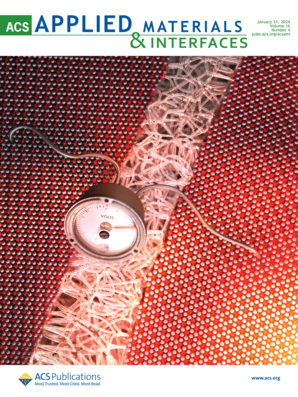紫外光激活双极性硅纳米线晶体管的伪分子掺杂氨传感。
IF 8.3
2区 材料科学
Q1 MATERIALS SCIENCE, MULTIDISCIPLINARY
引用次数: 0
摘要
与传统的替代杂质相比,被吸附的气体分子产生用于热激发电荷载流子输运的浅电子态和设计硅晶体管性能的潜力在很大程度上被忽视了。本文成功地利用氨(NH3)的还原特性对双极性无硅结纳米线晶体管(Si-JNTs)的电学性能进行了修饰,用于选择性检测。NH3的物理吸附在双极性Si-JNTs的p型和n型传导通道中引起了双重响应,显著改变了电流和关键参数,包括“导通”电流(Ion)、阈值电压(Vth)和迁移率(μ)。根据密度泛函理论(DFT)的计算结果,NH3相互作用增加了n通道的电导率,降低了p通道的电导率,起到了电子供体和空穴陷阱的作用。这为双极性Si-JNTs的电荷转移和″伪″分子掺杂提供了一条途径。这种NH3介导的分子掺杂和Si晶体管的传导调制首次实现了室温下宽浓度范围(200 ppb至50 ppm)下气态NH3的电检测,在紫外线(UV)光下实现了高灵敏度(200 ppb)和精确的选择性。紫外光照动态调制电流,并在双响应Si-JNTs的p和n通道中显示出不同的传感特征。双极性Si-JNT传感器在空穴传导通道中对0.8 ppm NH3的响应时间为1.91 min,在电子传导通道中对0.8 ppm NH3的灵敏度高达80%。这种双通道方法通过利用每个通道最灵敏的参数来优化传感器性能。此外,Si-JNT的双极性为开发多元校准模型拓宽了参数空间,提高了Si-JNT传感器对NH3检测的选择性。本文章由计算机程序翻译,如有差异,请以英文原文为准。
Ammonia Sensing via Pseudo Molecular Doping in UV-Activated Ambipolar Silicon Nanowire Transistors.
The potential of adsorbed gaseous molecules to create shallow electronic states for thermally excited charge carrier transport and to engineer silicon transistor properties has been largely overlooked compared to traditional substitutional impurities. This paper successfully modifies the electrical properties of ambipolar silicon junctionless nanowire transistors (Si-JNTs) using the reducing properties of ammonia (NH3) for selective detection. Physisorption of NH3 induces a dual response in both p- and n-type conduction channels of ambipolar Si-JNTs, significantly altering current and key parameters, including the "on" current (Ion), threshold voltage (Vth), and mobility (μ). NH3 interaction increases conduction in the n-channel and decreases it in the p-channel, acting as an electron donor and hole trap, as supported by Density Functional Theory (DFT) calculations. This provides a pathway for charge transfer and ″pseudo″ molecular doping in ambipolar Si-JNTs. This NH3-mediated molecular doping and conduction modulation in Si transistor enabled, for the first time, the electrical detection of gaseous NH3 at room temperature across a wide concentration range (200 ppb to 50 ppm), achieving high sensitivity (200 ppb) and precise selectivity under ultraviolet (UV) light. UV illumination dynamically modulates current and reveals distinct sensing features in the p- and n-channels of the dual-responsive Si-JNTs. The ambipolar Si-JNT sensor exhibits a fast response time of 1.91 min for 0.8 ppm of NH3 in the hole conduction channel and a high sensitivity of 80% for 0.8 ppm of NH3 in the electron conduction channel. This dual-channel approach optimizes sensor performance by leveraging the most responsive parameters from each channel. Furthermore, the ambipolarity of Si-JNTs broadens the parameter space for developing a multivariate calibration model, enhancing the selectivity of Si-JNT sensors for NH3 detection.
求助全文
通过发布文献求助,成功后即可免费获取论文全文。
去求助
来源期刊

ACS Applied Materials & Interfaces
工程技术-材料科学:综合
CiteScore
16.00
自引率
6.30%
发文量
4978
审稿时长
1.8 months
期刊介绍:
ACS Applied Materials & Interfaces is a leading interdisciplinary journal that brings together chemists, engineers, physicists, and biologists to explore the development and utilization of newly-discovered materials and interfacial processes for specific applications. Our journal has experienced remarkable growth since its establishment in 2009, both in terms of the number of articles published and the impact of the research showcased. We are proud to foster a truly global community, with the majority of published articles originating from outside the United States, reflecting the rapid growth of applied research worldwide.
 求助内容:
求助内容: 应助结果提醒方式:
应助结果提醒方式:


